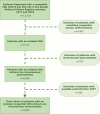Psychiatric morbidity and work participation in patients with congenital ventricular septal defects: a case-controlled study
- PMID: 38179669
- PMCID: PMC11398907
- DOI: 10.1093/ehjqcco/qcad072
Psychiatric morbidity and work participation in patients with congenital ventricular septal defects: a case-controlled study
Abstract
Background: The burden of psychiatric morbidity, level of education, and work participation are currently unknown in patients with congenital ventricular septal defects (VSD).
Methods and results: In a Danish population-based cohort study using nationwide medical registries, the burden of psychiatric disorders, use of psychotropic agents, level of education, and work participation were examined in patients with isolated congenital VSD and controls from the general population matched by age and sex. Subjects with known chromosomal abnormalities were excluded. To compute estimates, Cox proportional regression model, Fine and Gray's competing risk regression, and Kaplan-Meier failure function were used. We included 8006 patients and 79 568 controls born before 2018. Median follow-up was 23 years. Compared with controls, patients with VSD displayed a hazard ratio (HR) of 1.24 [95% confidence interval (CI): 1.17-1.32] for any psychiatric disorder where the hazard for intellectual disabilities was most pronounced [HR of 3.66 (95% CI: 2.98-4.50)]. The use of psychotropic agents was higher in patients compared with controls [HR 1.14 (95% CI: 1.09-1.20)]. The work participation was lower in patients with VSD compared with controls (P < 0.001) and was lower in patients with VSD with a psychiatric disorder compared with those without (P < 0.001). The 40-year cumulative incidence of permanent social security benefits was 29% in patients with psychiatric disorders (vs. 21% in controls with psychiatric disorders) and 8% in patients without psychiatric disorders (vs. 4% in controls).
Conclusion: Patients with isolated VSD suffer from a higher burden of psychiatric disorders and display lower work participation compared with matched controls from the general Danish population. It is important to consider longer-term impacts on mental health, education, and subsequent employment in patients with VSD, in addition to cardiovascular effects, as these factors severely affect quality of life and have direct socioeconomic implications on an individual and societal level.
Keywords: Congenital heart disease; Education; Nationwide; Psychiatric disorders; Ventricular septal defect; Work participation.
© The Author(s) 2024. Published by Oxford University Press on behalf of the European Society of Cardiology.
Conflict of interest statement
None to declare.
Figures





Similar articles
-
Lifetime Burden of Morbidity in Patients With Isolated Congenital Ventricular Septal Defect.J Am Heart Assoc. 2023 Jan 3;12(1):e027477. doi: 10.1161/JAHA.122.027477. Epub 2022 Dec 24. J Am Heart Assoc. 2023. PMID: 36565179 Free PMC article.
-
Survival of patients with congenital ventricular septal defect.Eur Heart J. 2023 Jan 1;44(1):54-61. doi: 10.1093/eurheartj/ehac618. Eur Heart J. 2023. PMID: 36418929 Free PMC article.
-
Risk of Lifetime Psychiatric Morbidity in Adults With Atrial Septal Defect (from a Nation-Wide Cohort).Am J Cardiol. 2020 Aug 1;128:1-6. doi: 10.1016/j.amjcard.2020.04.047. Epub 2020 May 19. Am J Cardiol. 2020. PMID: 32650900
-
Mortality and morbidity in patients with osteogenesis imperfecta in Denmark.Dan Med J. 2018 Apr;65(4):B5454. Dan Med J. 2018. PMID: 29619932 Review.
-
Tricuspid valve detachment for ventricular septal defect closure: A meta-analysis of existing evidence.J Card Surg. 2022 Dec;37(12):5395-5403. doi: 10.1111/jocs.17214. Epub 2022 Nov 15. J Card Surg. 2022. PMID: 36378918 Review.
Cited by
-
Psychiatric and Psychological Implications of Congenital Heart Disease.J Clin Med. 2025 Apr 26;14(9):3004. doi: 10.3390/jcm14093004. J Clin Med. 2025. PMID: 40364035 Free PMC article. Review.
References
-
- Marelli AJ, Mackie AS, Ionescu-Ittu R, Rahme E, Pilote L. Congenital heart disease in the general population: changing prevalence and age distribution. Circulation 2007;115:163–172. - PubMed
-
- Webb GD. Care of adults with congenital heart disease—a challenge for the new millennium. Thorac Cardiovasc Surg 2001;49:30–34. - PubMed
-
- Crossland DS, Jackson SP, Lyall R, Burn J, O'Sullivan JJ. Employment and advice regarding careers for adults with congenital heart disease. Cardiol Young 2005;15:391–395. - PubMed
-
- Geyer S, Norozi K, Buchhorn R, Wessel A. Chances of employment in women and men after surgery of congenital heart disease: comparisons between patients and the general population. Congenit Heart Dis 2009;4:25–33. - PubMed
Publication types
MeSH terms
Grants and funding
LinkOut - more resources
Full Text Sources
Medical

